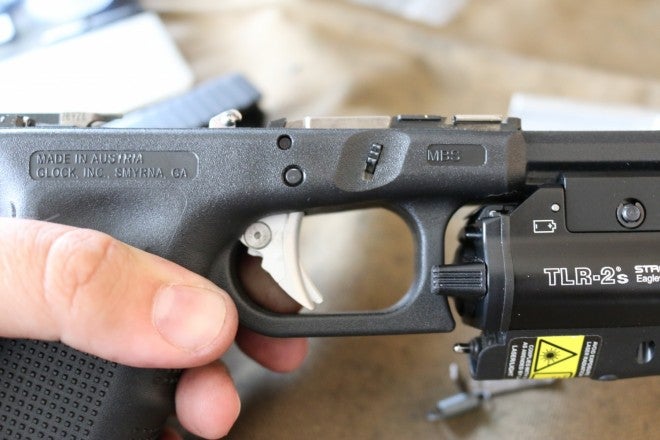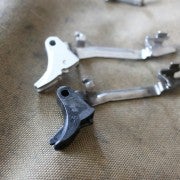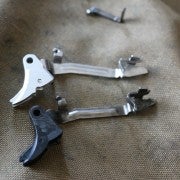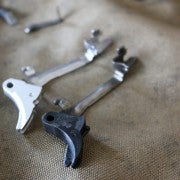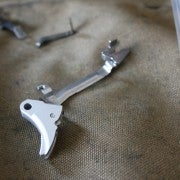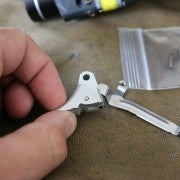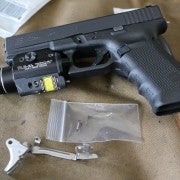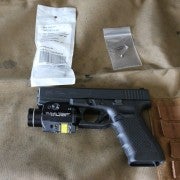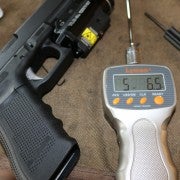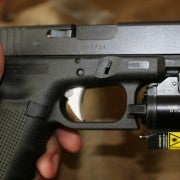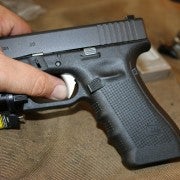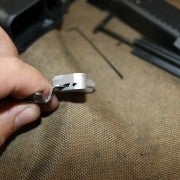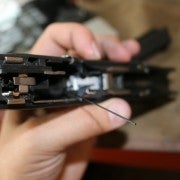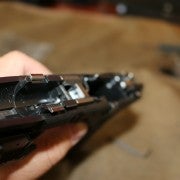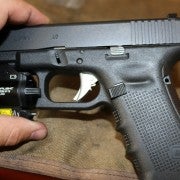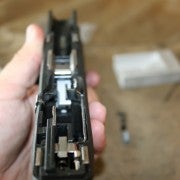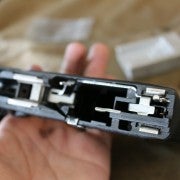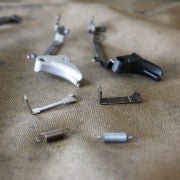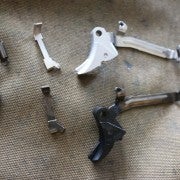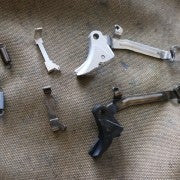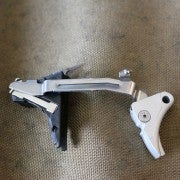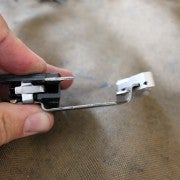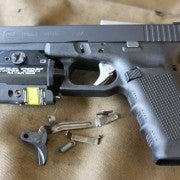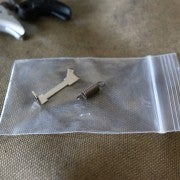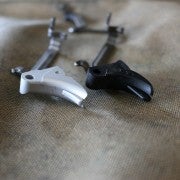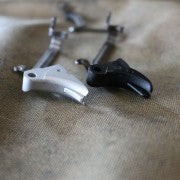Since I started shooting handguns, I have gravitated towards Glocks. Not because they are pretty (though pretty utilitarian), but because I chose a platform that has immense aftermarket support. Now down to only a single “stock” Glock, the others invariably have collected parts from Lone Wolf Distributors, which is the largest name in Glock parts.
In my competition handguns I have Lone Wolf conversion barrels, Lone Wolf polished guide rods, and a myriad of other parts like Dawson sights, etc. However, none of the guns have had a Lone Wolf trigger, as this was the last component Lone Wolf had yet to make to round out their bevy of parts (they say they support over 10,000 SKUs). In fact, my competition guns currently have ZEV’s full Fulcrum trigger kit.
Knowing this, Lone Wolf’s felt they were up to the task sent out one of their brand-new Ultimate Adjustable Triggers (UAT) packaged with a 3.5 lbs connector and 6 lbs spring for our critical review. So, does the UAT displace the ZEV? Read below to see our opinion and verdict.
Installation & Adjustment:
For the testing, the UAT was going to be installed in my Glock 22 and Glock 23 handguns. Both are shot regularly and are my two daily carry and general defense handguns. Its common for me to shoot them using Lone Wolf 9mm conversion barrels and then carry with their factory .40 S&W barrels.

Stock (bottom) and Lone Wolf UAT (Top)

Stock vs. New (Top)
The trigger and parts arrived packaged sparsely, with the UAT in a hot-sealed plastic baggie and the spring and disconnector in standard ULINE small parts packaging. Everything is utilitarian and dare I say inspired by the bleak factory packaging of the handgun they will be installed in. Included with the trigger is the adjustment hex wrench, which is a tiny little bugger.

As packaged, prior to installation.
If you know how to take apart a Glock, installation is a snap. For those that do not, pop out three pins, pull the trigger assembly out of the handgun, and start replacing parts. Considering the bevy of YouTube videos that show on top of telling, I will spare you details, but suffice it to say, everything goes together as promised.

Goes together quickly.
From the factory, the trigger is not adjusted outside of ensuring the small hex screws are inside the trigger. Pulling it for the first time was reliving a standard Glock pull, but this time with a comfortable shoe to pull with, albeit slightly smoother. I was not impressed, but was hopeful on what it could become.
Adjustment is a snap. Using the included tiny Allen key, I went right to work on the pre-travel inserting the key into the front of the trigger while still in the frame. Leaving the passive safety engaged, I adjusted the screw until it would not let me adjust it further. At this point, the trigger is not pull-able, as the passive safety cannot pivot out of the way. From there, I adjusted it back such that the passive safety would disengage when my finger touched it lightly.

Front adjustment

Rear adjustment location.
The pull now was significantly shorter and felt great to the finger, but over-travel was present. Unlike the ease of adjusting pre-travel, over-travel was significantly harder. While still adjustable in the frame, the user has to use the short section of the hex key and get in behind the trigger inside the magazine well. Easier said than done, as it’s all by feel. Once inserted, the user can only adjust about 15-25 degrees of rotation. As such, I took the trigger apart, used my judgement and twisted it to about 90% of the right place and then would put the finishing touches to it while installed.

Adjusted starting pull position.

Bang!
Final Pull
Now adjusted, the trigger and its accompanying accessories came into their own. Long gone was the stock “Glock” trigger and replaced was a remarkably pleasant tactile experience. If I had to compare it to anything, it was like the ALG QMS trigger for the AR-15. Slight amount of pre-travel and a steady, short, and firm pull through to the break. According to the Lyman digital trigger gauge, pull stayed steady at about 5.5 lbs, even with the lighter connector and heavier spring.
Running drills at the range was significantly more enjoyable. The trigger makes it easy to feel the heavier pull and with a clean press, releases the shot without issue. Compared to the stock trigger, the speed up my accurate shooting and I was slightly more accurate in speed drills. Boy, what a difference a trigger can make.

Sharp looking thing.
UAT vs. ZEV Fulcrum
As mentioned earlier, I own two sets of ZEV’s Fulcrum drop-in trigger kit, and suffice to saw, the UAT is heads and shoulders above this in terms of adjustment. ZEV’s kit requires disassembly from the frame. But, the trigger pulls could not be more different.
The UAT is a shorter, heavier pull whereas the ZEV is a smoother, lighter, and longer experience. The UAT is perfect for carry, but I like the lesser weight of the ZEV as it keeps me on target when going full-tilt boogie during 3-gun. That said, it can be so light that during a fight-or-flight situation I may have a negligent discharge.
**Kudos to the engineers at Lone Wolf. My principal beef with the ZEV trigger is the pull from the original position. ZEV’s passive safety requires the trigger to be much farther forward than actually required to reset the trigger. While not an issue during competition where one rides the reset, its annoying and shows that the engineering on this was not through. The UAT’s passive safety disengagement point is just past the reset, eliminating unneeded pull.
So to me, I am glad to have both triggers. The UAT rounds out the ultimate in duty and general shooter, the ZEV specifically competition-oriented, but do not discount the UAT if one opts to polish the firing pin safety, lighten the main spring, and replace the firing pin as the full ZEV kit offers.
Still, the UAT is far more comfortable. The ZEV has a flat face with a curved bow, The UAT has radiused edge on both sides.

The screw on the right hand of the trigger would allow you to completely disassemble the trigger. Its always covered when installed, so its not backing out. Still, recommend blue Loc-Tite.
The Good:
- The completed kit took a true factory Glock trigger and it now feels like a ALG Defense QMS trigger on an AR (still some creep, but good enough for semi-precision work). This is high-praise for a drop-in kit.
- Fully adjustable for take-up and over-travel without having to remove the trigger from the frame.
- Smooth face and radiused edges make in incredibly comfortable.
- Someone spent some time engineering the safety to engage right at the reset point.
- $74.95 is the least expensive trigger I have seen for an aftermarket Glock, period.
The Notable
- My very early edition trigger sent for testing had a small “tick” on the passive safety. Lone Wolf has kits to fix this which required removing the trigger from the frame and replacing the passive safety spring.
- Recommend this is purchased as a pack with the provided accessories. Otherwise, its only just taking a stock Glock pull and making it shorter.
The Bad:
- Available in non-anodized finish (bare aluminum) for now. Lone Wolf has communicated other versions are planned.
- Adjusting the over-travel while still in the frame is a PITA. Its an awkward angle for the small included hex wrench and only allows you to rotate a few degrees until hitting the frame. It was easier to adjust this removing the trigger from the frame.

Final Thoughts
Having now put hundreds of rounds downrange with the UAT, I am quick to recommend it. The adjustable trigger is a great value for what you get, even if I would like to see some colors (at least black and red, please). Further, I would recommend that it is purchased with the same kit, otherwise a shooter is just making a stock Glock pull shorter – not a solid goal in my book.
Now, the UAT is not supplanting the ZEV on my competition guns, but it is firmly in my EDC, which is arguably higher praise. The ZEV kit may be smoother and lighter, but the pull is longer. The UAT’s heavy and discernible wall makes a duty Glock a heck of a lot better, which is – to me – what Glocks were meant to be.
For $74.95, the UAT is a bargain. Adding in the spring and connector brings the upgrade to a reasonable $87, prior to shipping. That flat-out beats any other aftermarket trigger I am aware of. Throw in the ease of adjustment, comfortable shape, and spot-on pull, this is the trigger to beat for everything but the highest-end of race guns.
- Rear adjustment location.
- Front adjustment
- The screw on the right hand of the trigger would allow you to completely disassemble the trigger. Its always covered when installed, so its not backing out. Still, recommend blue Loc-Tite.
- Goes together quickly.
- Sharp looking thing.
 Your Privacy Choices
Your Privacy Choices
